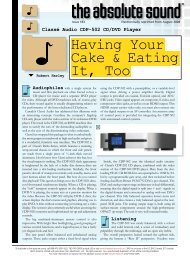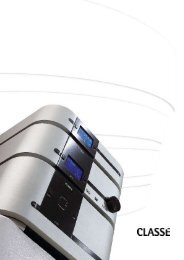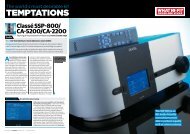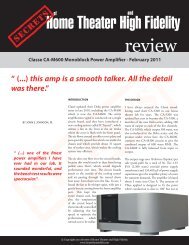Owner's Manual SSP-600 Surround Processor - Classé Audio
Owner's Manual SSP-600 Surround Processor - Classé Audio
Owner's Manual SSP-600 Surround Processor - Classé Audio
You also want an ePaper? Increase the reach of your titles
YUMPU automatically turns print PDFs into web optimized ePapers that Google loves.
Initial Setup<br />
We understand that you may be anxious to begin enjoying your new surround<br />
processor. Our best advice: take advantage of the considerable experience your<br />
Classé dealer offers to make sure you get all the performance you deserve.<br />
However, if you want to set up your new system yourself, this section is<br />
designed to get the system up and running quickly. Following the steps outlined<br />
below will not fully optimize your system, since doing so involves optimizing<br />
everything in the system – not merely your surround processor. But we can get<br />
you off to a good start, assuming that the rest of the system is approximately as it<br />
should be.<br />
Your new <strong>SSP</strong>-<strong>600</strong> is delivered with default factory settings which this section<br />
will use to make your initial task simpler. Please note that these default settings<br />
cannot deliver all the performance and functionality that the <strong>SSP</strong>-<strong>600</strong> offers in<br />
your particular system. For a full understanding of the capabilities of your new<br />
surround sound preamplifier/processor, you should still read the rest of this<br />
manual – particularly the section describing the menu system.<br />
1 Plug everything into the AC mains, but make sure everything is off<br />
or in standby.<br />
By plugging everything into the wall, you ensure that every component is<br />
grounded and lessen the chances of a static discharge damaging delicate<br />
electronics. However, it is important that everything be turned off before<br />
you begin, especially the power amplifiers. You do not want a transient<br />
from making a connection to be amplified by your power amplifiers and<br />
sent to the speakers.<br />
2 Connect your source components to the <strong>SSP</strong>-<strong>600</strong>.<br />
By default, the INPUT1 button is associated with the LINE1 analog audio<br />
connection. INPUT2 button with LINE2, INPUT3 button with LINE3,<br />
etc. Analog audio sources such as tuners should be connected to any<br />
available LINE connectors. Make a note of where you are connecting your<br />
various sources.<br />
3 Connect your <strong>SSP</strong>-<strong>600</strong> to your power amplifier(s).<br />
Connect the Main Outputs of the <strong>SSP</strong>-<strong>600</strong> to the corresponding inputs<br />
on your various amplifier channels, being careful not to mix them up.<br />
In particular, make sure the SUB output is sent only to an appropriate<br />
subwoofer – the extremely low frequencies often sent from the SUB output<br />
could damage a small speaker that was not designed for those frequencies.<br />
4 After making sure that the amplifiers are off or in standby,<br />
connect them to the appropriate loudspeakers.<br />
Pay close attention to the phase of the speaker connections. Always<br />
connect red (+) terminals to red (+) terminals, and black (–) terminals to<br />
black (–) terminals.<br />
16
















